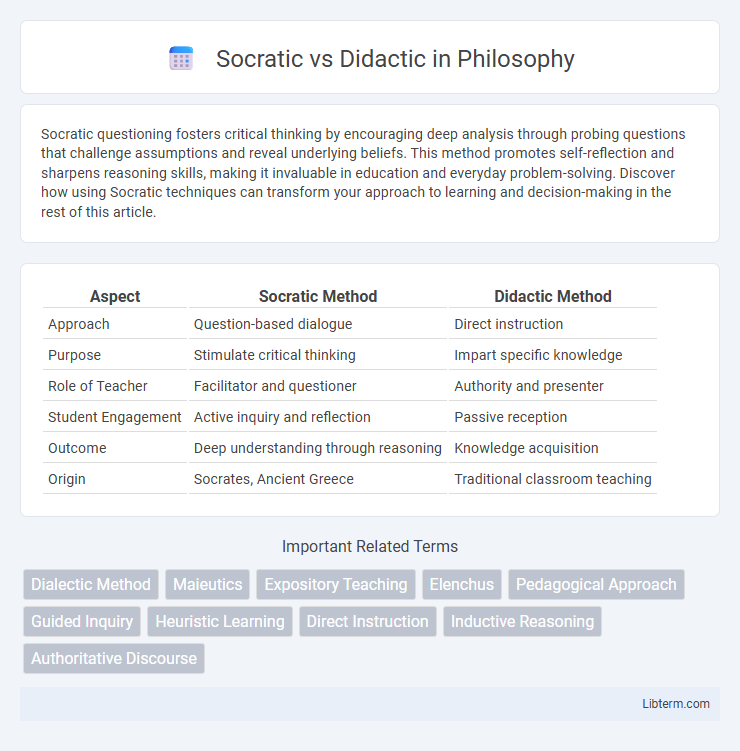Socratic questioning fosters critical thinking by encouraging deep analysis through probing questions that challenge assumptions and reveal underlying beliefs. This method promotes self-reflection and sharpens reasoning skills, making it invaluable in education and everyday problem-solving. Discover how using Socratic techniques can transform your approach to learning and decision-making in the rest of this article.
Table of Comparison
| Aspect | Socratic Method | Didactic Method |
|---|---|---|
| Approach | Question-based dialogue | Direct instruction |
| Purpose | Stimulate critical thinking | Impart specific knowledge |
| Role of Teacher | Facilitator and questioner | Authority and presenter |
| Student Engagement | Active inquiry and reflection | Passive reception |
| Outcome | Deep understanding through reasoning | Knowledge acquisition |
| Origin | Socrates, Ancient Greece | Traditional classroom teaching |
Introduction to Socratic and Didactic Methods
Socratic and Didactic methods represent distinct teaching approaches with Socratic focusing on guided questioning to stimulate critical thinking and self-discovery, while Didactic relies on direct instruction and information delivery from teacher to student. The Socratic method involves a dialogic process where instructors ask probing questions to encourage students to explore underlying concepts and challenge assumptions. Didactic teaching emphasizes structured content presentation, aiming for efficient knowledge transmission through lectures, demonstrations, and clear explanations.
Historical Origins and Development
The Socratic method originated in ancient Greece, pioneered by Socrates around the 5th century BCE, emphasizing dialectical questioning to stimulate critical thinking and illuminate ideas. In contrast, didactic teaching dates back to early civilizations but was formalized by figures like Aristotle, focusing on direct instruction and moral lessons to impart knowledge clearly and efficiently. Over centuries, the Socratic method evolved into a tool for fostering dialogue and inquiry, while didactic methods shaped structured curricula and authoritative knowledge transfer.
Core Principles of the Socratic Approach
The Socratic approach centers on fostering critical thinking through dialogue, emphasizing questioning over direct instruction to stimulate deeper understanding and self-reflection. It relies on the method of elenchus, where probing questions expose contradictions and encourage learners to refine their beliefs. This technique prioritizes active learner engagement, collaborative exploration, and the development of analytical skills rather than rote memorization or passive reception of information.
Key Features of Didactic Teaching
Didactic teaching emphasizes structured, teacher-centered instruction where information is clearly presented with the goal of ensuring comprehension and retention. This approach relies heavily on lectures, demonstrations, and direct explanations to convey specific knowledge and skills. Key features include a fixed curriculum, clear learning objectives, and frequent assessment to measure student progress.
Socratic vs. Didactic: Philosophical Foundations
The Socratic method is grounded in the philosophy of critical inquiry, encouraging learners to engage in dialogue, question assumptions, and develop independent thinking through dialectical reasoning. Didactic teaching, rooted in Aristotelian epistemology, emphasizes the transmission of established knowledge from teacher to student in a structured, authoritative manner. While Socratic pedagogy fosters active intellectual exploration and self-discovery, Didactic instruction prioritizes clear, direct communication of information to ensure comprehension and retention.
Advantages of the Socratic Method
The Socratic Method enhances critical thinking by encouraging students to question assumptions and explore underlying concepts through dialogue. This interactive approach fosters deeper understanding and retention compared to didactic teaching, which often relies on passive information delivery. By promoting active participation, the Socratic Method cultivates analytical skills and independent reasoning essential for problem-solving.
Benefits and Limitations of Didactic Instruction
Didactic instruction offers clear structure and efficient knowledge transfer, making it suitable for large groups and standardized curricula. However, it often limits critical thinking and learner engagement by emphasizing passive reception over active participation. This approach can be less adaptive to individual learning styles and may hinder deeper understanding compared to more interactive methods like the Socratic approach.
Socratic and Didactic Methods in Modern Education
Socratic and Didactic methods represent two contrasting approaches in modern education, where the Socratic method emphasizes critical thinking through dialogue and questioning, fostering deep understanding and student engagement. The Didactic method centers on direct instruction and content delivery, prioritizing clear, structured teaching often seen in traditional classrooms. Contemporary education increasingly blends these methods, leveraging Socratic techniques for discussion-based learning while using Didactic approaches for foundational knowledge acquisition.
Practical Applications and Case Studies
Socratic method emphasizes critical thinking and dialogue, making it ideal for law schools and medical training programs where problem-solving and ethical reasoning are essential. Didactic teaching, which delivers structured information, is widely used in STEM fields and large lecture settings to efficiently cover substantial material. Case studies in business schools reveal that Socratic discussions enhance leadership skills, while didactic lectures improve foundational knowledge acquisition.
Choosing the Right Method for Effective Learning
Choosing the right method between Socratic and Didactic teaching hinges on the learner's needs and context. Socratic method emphasizes critical thinking through questioning and dialogue, fostering deep understanding and active engagement, especially effective in law and philosophy education. Didactic approach delivers structured, clear information efficiently, ideal for foundational knowledge building in subjects requiring straightforward fact transmission, such as mathematics or science.
Socratic Infographic

 libterm.com
libterm.com